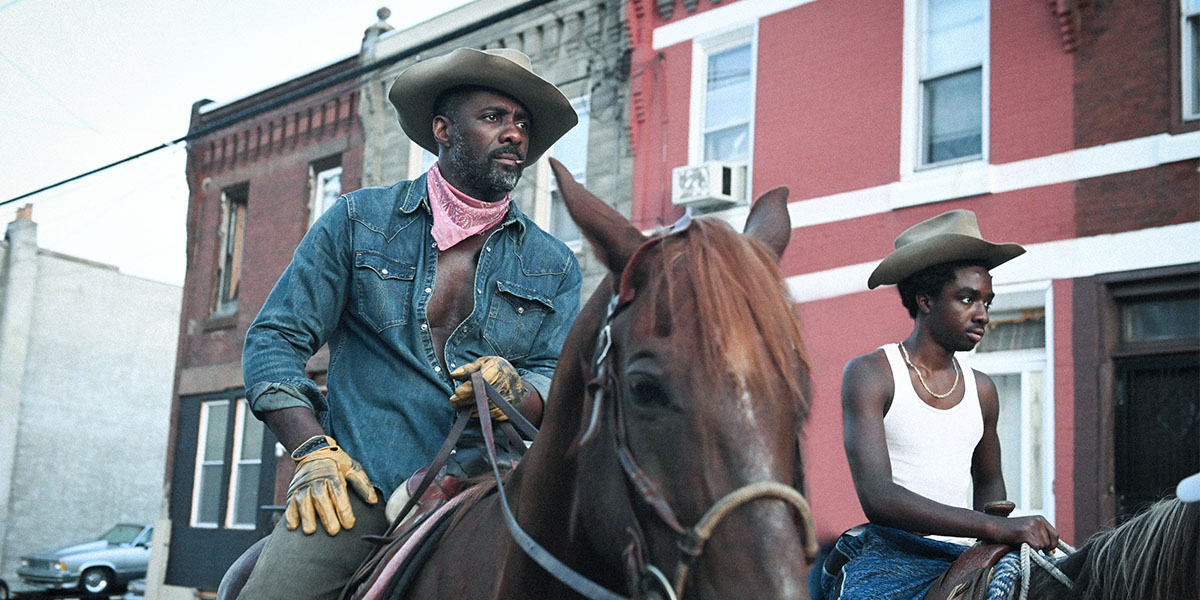A frustrating stretch of my virtual TIFF experience continued on Monday with a trio of movies with elements that work balanced out by frustrating flaws. This year’s TIFF feels like an odd feast-or-famine dynamic for me at least with movies like “Nomadland” and “Wolfwalkers” that would have made waves in any year but a notable lack of next-tier “good” movies, as if the movies that needed the most help from a premiere audience to go over decided to sit this one out, leaving us with a handful of greats and then, well, not so greats.
Ricky Staub’s “Concrete Cowboy” nearly works because of the strength of its cast, including great turns from future stars Caleb McLaughlin and Jharrel Jerome, two young men who really earned their most attention for Netflix projects—“Stranger Things” and “When They See Us”—but who clearly can hold the big screen too. The young talents are balanced by great veterans, including Idris Elba, Method Man, and Lorraine Toussaint. There’s something that’s just enjoyable about watching such a strong ensemble bounce off each other, but Staub’s script doesn’t give them enough to work with, resorting to obvious tropes and thin dialogue when this story needed something more genuine. There are enough stand-out moments, mostly ones in which the characters are just hanging out around the campfire and chatting, but the coming-of-age story feels manufactured at every turn.
McLaughlin plays Cole, a Detroit teen whose mom has had enough of his shit. She decides a change of scenery is in order, shuffling him off to Philly, where his dad lives, Elba’s Harp. It turns out there’s a group in North Philly called Fletcher Street, an urban horse community of horse riders and trainers. In a smart move, Staub uses several real members of the community in his cast, and they’re all surprisingly good performers too. The writer/director is clearly skilled in directing performance, and there’s a version of “Concrete Cowboy” that doesn’t bother at all with the coming-of-age story and just focuses on the daily existence of this unique corner of the country.
That’s not this movie. Cole and Harp butt heads from the beginning, as dad is clearly the kind of loner more interested in horses than people, and his son ends up reuniting with a local kid named Smush (Jerome), who is more engaged in the crime scene in Philly than the horse one. Shovel literal shit with dad or ride the high life with Smush? McLaughlin really does a very good job of selling a traditional narrative, but Staub’s dialogue rings false a few too many times. Someone literally says, “Hard things come before good things” in one scene, which I think is the motto of all coming-of-age stories, and another goes as far as to verbalize, “Horses ain’t the only thing that need breaking here.” You don’t say.
At its best, “Concrete Cowboy” is a fun hangout movie, with great actors and people from the story’s true aspects sitting around, talking about the way things used to be. It has a good community energy and rapport between the performers that makes the moments when it sinks back into generic tropes all the more frustrating.

There’s certainly nothing generic about Gianfranco Rosi’s “Notturno,” although it does fit in with the controversial director’s style of blending documentary filmmaking with what often feel like orchestrated situations. I’m a big fan of films that push the boundaries of what a documentary “should be” but there are times in Rosi’s films when the blurring of the lines feels almost exploitative in ways that I don’t think the filmmaker intends. Still, I appreciate his eye, his focus, and his willingness to challenge filmmaking forms. If you liked “Fire at Sea,” this serves a similar function.
Rosi’s focus this time is on the regions—mostly the borders—of countries destroyed by ISIS. He spent years there, filming different communities and people, often returning to the same ones in his film. He actually opens with his best shot, an amazing nighttime march by what looks like a large military battalion. A group of men roars past the camera and then fades into the distance only for another group to follow. And so on and so on. It’s a beautiful shot that’s also emblematic of the cyclical nature of the region he’s cinematically interrogating.
Cycles play out throughout “Notturno,” and they’re usually violent. A woman bemoans the loss of her child in a Turkish prison where he was held, a group of soldiers gets dressed in the morning in silence, and, in the film’s most devastating sequence, a teacher talks to some children about the horrors they’ve seen in their young lives. I will never forget the faces of kids drawing events like torture and beheadings in a children’s classroom. Rosi is clearly very concerned about not just the current nightmares unfolding in parts of this country but what the inflicted trauma will do to future generations.
Rosi has an impressive eye and empathetic style, but his approach also often feels overly staged and precious with its visuals. Almost as if he’s leaning into this criticism, he spends a lot of time (too much really) with a group of residents in a psychiatric show staging a show about the region and its violence. Are their emotions any lesser or different because they’re rehearsing and staging something? Arguably not, but I found a bit too much of “Notturno” to be more manipulative than enlightening, and that includes the children’s memories scene, which has undeniable power but pushes into exploitation of trauma.

Trauma also plays a role in Charles Officer’s crime saga “Akilla’s Escape,” a film in the “Planet Africa 25” program of TIFF this year. Officer has a good eye for neon-soaked drama but he allows style to overwhelm substance by a wide margin, clouding the power of his narrative even more with an alternating timeline story that drains both halves of the film. There’s a really solid performance at the center from poet/musician Saul Williams (who also worked with Massive Attack on the propulsive soundtrack) but it gets lost in everything around it.
Williams plays Akilla Brown, a power player in Toronto’s drug scene hoping to break out of it soon. One night near what he plans to be the end of his criminal career, a drug deal goes very wrong when robbers try to steal a stash. Akilla apprehends one of the robbers who has clearly underestimated who he has stolen from, and discovers that it’s basically just a kid, a Jamaican boy named Sheppard. Akilla sees himself at the same age in the boy’s scared face and then “Akilla’s Escape” alternates between the dealer trying to save the young man from retaliation while also chronicling how Brown got here himself.
The parallel cycles of young men being drawn into violent worlds is interesting but the structural choice lessens the urgency of Akilla & Sheppard’s fate by constantly going back to the flashback well. “Akilla’s Escape” is at its best when it feels dangerous, and flashbacks inherently soften that effect. It’s also a movie that’s in love with its technical elements a bit too much, over-reliant on stylish tricks when its greatest power is in Williams’ world-weary visage.












